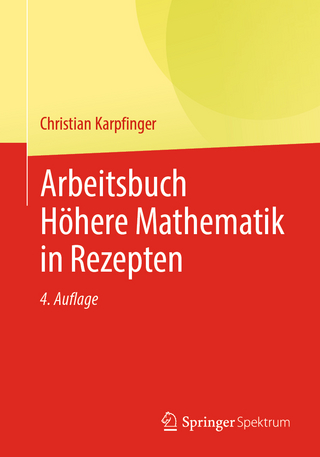
College Algebra and Trigonometry
Pearson (Verlag)
978-0-201-34712-8 (ISBN)
- Titel erscheint in neuer Auflage
- Artikel merken
P. Prerequisites.
Real Numbers and Their Properties.
Integral Exponents.
Rational Exponents and Radicals.
Polynomials.
Factoring Polynomials.
Rational Expressions.
1. Equations and Inequalities.
Linear Equations.
Applications.
Complex Numbers.
Quadratic Equations.
Linear and Absolute Value Inequalities.
Quadratic and Rational Inequalities.
2. Functions and Graphs.
The Cartesian Coordinate System.
Functions.
Graphs of Relations and Functions.
Transformations and Symmetry of Graphs.
Operations with Functions.
Inverse Functions.
Variation.
3. Polynomial and Rational Functions.
Linear Functions.
Quadratic Functions.
Zeros of Polynomial Functions.
The Theory of Equations.
Miscellaneous Equations.
Graphs of Polynomial Functions.
Graphs of Rational Functions.
4. Exponential and Logarithmic Functions.
Exponential Functions.
Logarithmic Functions.
Properties of Logarithms.
More Equations and Applications.
5. The Trigonometric Functions.
Angles and Their Measurements.
The Sine and Cosine Functions.
The Graphs of the Sine and Cosine Functions.
The Other Trigonometric Functions and Their Graphs.
The Inverse Trigonometric Functions.
Right Triangle Trigonometry.
6. Trigonometric Identities and Conditional Equations.
Basic Identities.
Verifying Identities.
Sum and Difference Identities.
Double-Angle and Half-Angle Identities.
Product and Sum Identities.
Conditional Equations.
7. Applications of Trigonometry.
The Law of Sines.
The Law of Cosines.
Vectors.
Trigonometric Form of Complex Numbers.
Powers and Roots of Complex Numbers.
Polar Equations.
Parametric Equations.
8. Systems of Equations and Inequalities.
Systems of Linear Equations in Two Variables.
Systems of Linear Equations in Three Variables.
Nonlinear Systems of Equations.
Partial Fractions.
Inequalities and Systems of Inequalities in Two Variables.
Linear Programming.
9. Matrices and Determinants.
Solving Linear Systems Using Matrices.
Operations with Matrices.
Multiplication of Matrices.
Inverses of Matrices.
Solution of Linear Systems in Two Variables.
Using Determinants.
Solution of Linear Systems in Three Variables Using Determinants.
10. The Conic Sections.
The Parabola.
The Ellipse and the Circle.
The Hyperbola.
11. Sequences, Series, and Probability.
Sequences.
Series.
Geometric Sequences and Series.
Counting and Permutations.
Combinations, Labeling, and the Binomial.
Theorem.
Probability.
Mathematical Induction.
| Erscheint lt. Verlag | 1.10.1998 |
|---|---|
| Sprache | englisch |
| Maße | 218 x 240 mm |
| Gewicht | 1821 g |
| Themenwelt | Mathematik / Informatik ► Mathematik ► Algebra |
| Mathematik / Informatik ► Mathematik ► Geometrie / Topologie | |
| ISBN-10 | 0-201-34712-1 / 0201347121 |
| ISBN-13 | 978-0-201-34712-8 / 9780201347128 |
| Zustand | Neuware |
| Haben Sie eine Frage zum Produkt? |
aus dem Bereich



